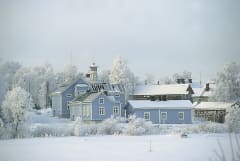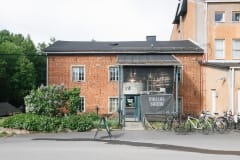Wooden old towns, churchtowns and lighthouses – coastal history tour
Sweden and Finland share history not only as neighbouring countries, but also as being one country. Sweden conquered Finland through the crusades and the coastal areas were first entered. In this era trade, fishing, shipbuilding and tar burning were the livelihoods of the coast. The charming coastal old towns of Kokkola, Pietarsaari, Kalajoki and Oulu tell the story of these trades. As the church was very strong and church duty applied in Sweden, were churchtowns built in the northern parts of the country, i.e. collection of small houses, built next to the church and used for temporary housing. The church towns arose in areas where the parishioners had long distances from the church and there was a need to stay overnight in connection with church visits. We visit churchtowns in Luleå, Piteå and two in Skellefteå area.
However, a coast would not be anything without its lighthouses. Traffic in the Bothnian Bay has long and respectable traditions. In the 17th century increased merchant sailing led cities to systematically improve the marking of their shipping lanes. Also land uplift of the coast contributed to the fact that underwater rocks and roaches constantly produced surprises even in familiar passageways. The history of the lighthouses located along Bothnian Coastal Route is connected to the development of the cities to centres of trade and tar exports, and the conditions for shipping needed to be improved.
- This itinerary can be done by groups or individuals.
- For groups we recommend to have a look at the local charter transportation options on our Get Around page.
- For self-driving guests, our Distance table might be handy.
- Local guides will tell their part of the story in each destination.
Day 1: Arrival in Vaasa
Arrival at Vaasa (VAA) airport.
Several flight connections from Europe are available via Helsinki Vantaa. Alternative airport: Kokkola (KOK).
Check in to Sokos Hotel Royal, dinner at the hotel.
Day 2: Vaasa & Pietarsaari
Breakfast and check-out from Sokos Hotel Royal.
We start the day with a plunge into the history, geography and nature of the southern region of Bothnian Coastal Route. A guided tour takes you through the Ostrobothnian Museum.
Transfer to Pietarsaari where we visit the first old wooden town, Skata. This is one of Finlands largest continuous area of old wooden houses. Originally the area was inhabited by seamen and still today Skata serves as a residential area. A walking tour with a local guide will place Skata on the coastal map for you and enlighten a part of coastal history.
We cruise to Mässkär, a lighthouse and pilotstation island. Groups can have lunch on board M/S Mässkär, for individuals the Cafe & Restaurant on Mässskär is recommended.
M/S Mässkär cruises early June until end August. The vessel can be chartered for groups min 20 persons until end of September.
On Mässkär we discover the beacon and pilot station on the island. Mässskär is in the outer archipelago and also displays the peculiar, harsh and beautifully tender nature.
Overnight in Stadshotellet in Pietarsaari, where also dinner is served.
Day 3: Kokkola & Kalajoki
Breakfast at Stadshotellet.
In Kokkola we start with a walking tour in Neristan, the old wooden town that once was a harbour city. We get to hear about gossip mirrors, fire insurances and see estates and cottages that still serve as homes. Mid-tour we stop at The Waffel Café for lunch (savory waffel). The tour ends at Laivurintalo, which is a private home and also displaying a home from the 17th century. Our hostess is a brilliant storyteller and we will for sure learn about the shipbuilding and seafaring history of Kokkola over a cup of coffee.
In the afternoon we visit Old Plassi which is the old quarter of Kalajoki. Here only a small collection of old houses remain and the most interesting are Fia’s cottage and Fishing museum. Fishing and seal hunting were important coastal livelihoods and also a quite rough life to live.
Overnight in The Tradehouse of Lang, Raahe. Dinner is served on arrival.
Day 4: Raahe & Ii
Breakfast at Trade House of Lang.
The hotel has already taken you to 19th century Raahe and given you an insight off the life in this once wealthy trading port. A guided tour through old town of Raahe.
Raahe’s history is rich with vibrant personalities, from influential men and strong women to seasoned sailors and captains. The town, once prosperous from maritime trade, also boasted skilled craftsmen like tailors, coppersmiths, and sailmakers.
After the tour we have lunch in Trade House of Lang.
Our next stop is a true hidden gem. Tiny village with the funny name Ii was once an important port for trading of salmon tar and furs, gathering people not only from the Bothnian coast but Stockholm and even Carelia.
Drive to Oulu, accommodation and dinner at Radisson Blu Hotel.
Day 5: Oulu & HaparandaTornio
Breakfast at the hotel.
A local guide takes you on a walking tour to Pikisaari, where we hear about the tar burning and its importants on a coast where trade, seafaring and fishing took place in wooden boats.
Lunch in Sokeri-Jussin tavern. The tavern, occupies a historic log building once central to shipbuilding. The restaurant embraces its coastal heritage, offering an authentic and nostalgic experience alongside good food.
Our journey continues to HaparandaTornio, the twin-city on the border between Sweden and Finland. Here the common history really comes together and is crowned by a village that is split by a national border and a local language that mixes Swedish and Finnish. In Tornio we visit the Museum of Torne Valley to get an insight to the coastal and riverside culture and introduces the northern region of Bothnian Coastal Route.
Accommodation and dinner in Haparanda Stadshotell.
Day 6: Piteå & Luleå
Breakfast at Haparanda Stadshotell.
We shift our focus from coastal livelihoods to church-history as we explore northern Swedish coastal pearls. The best-preserved church towns in the country are in northern Sweden and they are protected as cultural heritage sites. The largest are in Piteå Gammelstad (Öjebyn) and Luleå Gammelstad, the latter being a UNESCO World Heritage site since 1996. In Lövånger church town, cottages have been adapted for overnight stays, offering an authentic experience. The church town tradition dates back to the 1600s.
Our discovery of the churchtowns begins in Luleå Gammelstad Visitor Center. Before exploring the churchtown and the church on a guided walk, we have lunch in Kaptensgården. We continue to the open-air museum Hägnan by the churchtown and after the tour we have a Swedish fika in one of the cafés in the area.
Accommodation and dinner in Elite Stadshotell in Luleå city.
Day 7: Piteå & Skellefteå
Breakfast at Elite Stadshotell.
We continue to explore the picturesque churchtowns of northern Sweden and head for Piteå.
Öjebyn churchtown is much smaller than Gammelstaden in Luleå and is set around a medival church. The churchtown used to be on the coast, however, due to land uplift, it is now around 10 km inland. Öjebyn churchtown dates back to 15th century.
The next churchtown is only one hour’s drive away, in Skellefteå. For groups lunch can be arranged in Stifstgården, and FIT-travelers will find many options in Skellefteå for grabbing a bite.
Bonnstan, meaning Peasants town, is the only preserved church town that is not electrified, making it the most traditional. It features 114 houses and 376 rooms, with some single-story houses having four rooms and others two-story houses with eight rooms. The houses are arranged in straight rows following a grid system. Bonnstan’s rooms are privately owned, and the area was designated as a cultural heritage site in 1982.
Accommodation and dinner in Medlefors Hotel.
Day 8: Skellefteå
Breakfast at Medlefors Hotel.
Today we will visit a remarkable Swedish lighthouse. Bjuröklubb is a prominent peninsula within a nationally significant cultural heritage area. Bjuröklubb lighthouse, built in 1859, is one of 25 Swedish national heritage lighthouses due to its unique features, geographical location, and historical importance. The lighthouse keeper’s residence housed the meteorologist who provided weather data before automation.
Before leaving Bjuröklubb we will have a nice Swedish fika (coffee break) in the garden of the café close to the lighthouse.
Next churchtown is only a short drive away, in Lövånger. We start with a home made lunch in the restaurant, before exploring the parish museum, church and churchtown. This churchtown is unique as one can stay overnight in the cute cottages, dating from 18th century. The cottages have been uopdated withe bathrooms and electricity, but otherwise the old charm has been kept and cherished.
Dinner is served at Lövånger gården restaurant.
Day 9: Umeå
Breakfast at Lövånger gården.
This morning we drive to Umeå, where the tour ends.
A last discovery of history is Västerbottens Museum. The open air part of the museum is called Gammlia and displays life as it was in olden days and will be a good wrap-up for the past days discoveries. One yet on this tour untouched feature that Västerbottens Museum will unveil for you is the life and history of the Sámi people.
Lunch is enjoyed in the cafeteria on the premises of the museum.
Accommodation and dinner in Clarion Collection Hotel Uman.
The hotel serves Swedish fika daily 15:00-17:00, maybe you gather around a cup of coffee to reflect on the past days impressions and discoveries.
Day 10: Departure from Umeå
Departure from Umeå airport (UME).
Several flight connections to Europe via Stockholm/Arlanda available.
Departure by Wasaline to Finland.
In case you are travelling with a Finnish rental car, you might need to take the Wasaline ferry to Vaasa and depart from there.






























